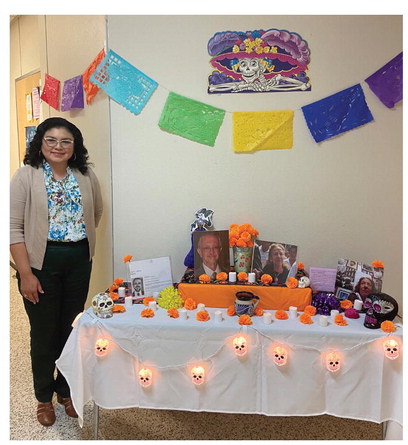While people are making Halloween plans and decorating their porches with pumpkins and spooky decorations, others are making plans to celebrate a different holiday — El Dia de los Muertos, better known in America as The Day of the Dead.
Many view Day of the Dead as a Hispanic version of Halloween, but that is not the case. “It’s not to be confused or identified with Halloween,” Spanish professor Dr. Cynthia Pena said. While Day of the Dead and Halloween have similar roots in pagan traditions, they are two different holidays. The Day of the Dead is a result of a combination of pre-Hispanic traditions and the Catholic celebrations of the conquistadors. “When the Spaniards came in conquest time, they had these traditions of going to the cemeteries with candles, wine, and bread — in hopes that the spirits of their loved ones would come back and visit them,” Dr.
Pena said.
The Aztecs had a harvest celebration which included similar traditions. “They were doing it in August to celebrate the harvest, the end of their hard work and the collecting of all the goods which paid off for their work, and they celebrated their deceased ones at the same time,” Dr. Pena said.
After the conquest by the Spaniards, the Aztec celebration was moved to November to fit better with the Catholic calendar.
While Day of the Dead may sound like a fearful holiday to some, it actually is a joyous tradition for those who celebrate. “The Aztecs thought death was only one step to a different kind of life,” Dr. Pena said. She explained how the Aztecs believed in an afterlife where a person traveled on a long journey to Mictlan (the Land of the Dead) to be with Mictlantecuhtli (the Lord of the Death/ Dead). For their difficult journey, the souls were rewarded with a 24-hour trip back home to visit their families.
To entice the souls to return home, people will place offerings which represent the four elements of earth, wind, fire and water. Beautiful displays of flowers and plates of the deceased’s favorite food represent the earth. Candles bring the fire element while providing light for night time celebrations, and jars of water will be present as well. The wind is seen in the papel picado — special banners that have designs cut out to catch the wind.
Also during the Day of the Dead celebration is when the monarch butterflies are making their journey south for the winter. Many people will decorate cemeteries and graves with marigolds and candles as part of the Day of the Dead celebration, and the light from the candle and the vibrant colors of the marigolds will attract the butterflies.
“Especially the indigenous people from those areas believed those were the souls of their loved ones coming to visit them,” Dr. Pena said.
Day of the Dead has long been an important holiday in Mexico, but it only has recently started being widely celebrated. Before the late 20th century, it was mostly a rural holiday. “It became popular after 1980 in the city,” Dr. Pena said.
“My dad passed away in 1993. Two or three years after he passed away, I did my first ofrenda.”
An ofrenda is a type of altar in a home used to celebrate and remember the passing of a loved one. Ofrendas typically feature pictures of the deceased and symbols of the four elements.
Dr. Pena and her students together made an ofrenda at SWOSU to remember important Mexican leaders who have recently passed away.
The professor said she makes a point to teach her students that Day of the Dead is “an alwaysevolving celebration.” More than anything, though, she said it is a celebration, not a fearful holiday. “This is a celebration of life. This is not a celebration of death. Most of the time this is a very intimate celebration in the family.”
Much of the growth in popularity is due to recent films which have featured Day of the Dead. Dr.
Pena cited movies like Coco, The Book of Life, and Spectre as being particularly instrumental in growing the holiday’s popularity.
In fact, Spectre is the very reason why Mexico City now has a Day of the Dead parade. The movie features a scene where James Bond is running through a Day of the Dead parade in Mexico City, a parade which didn’t exist. Most of the props and costumes in the film were created by local artisans, and the film crew donated the pieces back to the city. “They were beautiful, and there were tons of them. So, Mexico City decided to have a parade,” Dr. Pena said. “One movie transformed the tradition.”
While Spectre has changed the way Day of the Dead is celebrated, Dr. Pena credits Coco for its accuracy in showing the traditions of the holiday.
“It showcases the most accurate to-date traditional point of the celebration. It’s still a movie; it’s still fiction, but it offers a nice idea.”
Dr. Pena said she personally appreciates the modern movies and stories that highlight the holiday. “It is putting the celebration in the world, and people will know more. They will be more aware about that. It’s not that we want them all to celebrate the same way. It’s always nice to know about these traditions around the world, especially when the United States is so close.”


